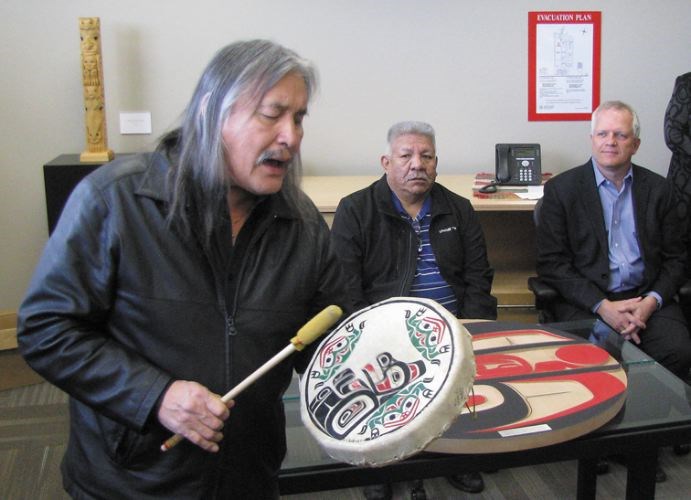This is not the traditional territory of the Nadleh Whut'en First Nation, but a large contingent of their people came to Prince George this past week to sign an agreement for a pipeline to pass through their historic lands.
The Nadleh Whut'en are from the region surrounding Fraser Lake. Their historic territory extends halfway down Francois Lake and touches Uncha Lake to the west, the Braeside and McCall communities to the east, to Knewstubb Lake at its southern end and Babine Lake to its northern end. On Highway 16, The Nadleh Whut'en land stretches between the rural communities of Engen and Savory, taking in the villages of Fort Fraser, Fraser Lake and Endako along the way.
TransCanada Pipelines is the company tasked with connecting the natural gas reserves in the Peace-region with the Pacific Ocean shipping routes on behalf of Shell Canada Ltd. and its partners. The proposed route is about 670 kms from Dawson Creek to Kitimat and would, should the Nadleh Whut'en people consent, pass through their territory.
That consent - although provisional - has now been given in writing. A ceremony was held in Prince George on Friday to formalize the deal. Although details were withheld by both sides, there is a component of the contract that provides the Nadleh Whut'en people with a level of training for the jobs that will need to be filled, and also ongoing income as long as the pipeline is in use (in exactly the same manner as municipalities receive industrial tax for such activities).
The Lheidli T'enneh First Nation signed a similar agreement this past December covering the territory in and around Prince George, and chief Dominic Frederick offered his congratulations to the pipeline company and Nadleh Whut'en people when he officially welcomed them to the signing ceremony at TransCanada Pipeline's office here in this city.
The Nadleh Whut'en and the Lheidli T'enneh have been closely associated nations for thousands of years, he said, and the announcement was pleasing for the two to share here.
Prince George mayor Lyn Hall was also present and said it was a positive sign that respectful business was being done. "I can't stress too strongly the importance of building relationships," he said.
The ceremony commenced with a performance by the Nadleh Whut'en drummers, including longtime elected chief Martin Louie.
There was also the unveiling of a piece of original art, a cedar circular carving by Coast Salish (Squamish First Nation) artist George Hemeon.
It will hang on the TransCanada Pipelines wall alongside a number of other artworks as, one by one, the founding communities of the region sign on for this proposal.
Rick Gateman, president of the Coastal GasLink project, said on behalf of the company that he was pleased with the dialogue he has heard from First Nations stakeholders along the route and this signing was evidence of being on the right path.
"You've read in the newspaper about LNG (liquefied natural gas) being a transformational industry, according to premier Christy Clark, and I agree with her, and one thing she said I really took to heart was how it will not leave a particular sector of the province (meaning aboriginal peoples) behind," Gateman said. "We are offering benefits, employment opportunities, contracting opportunities, and for us it makes good business sense to tap into local land-use knowledge, ecological knowledge, and employing people locally."
Chief Louie was both pleased with the deal at hand, but critical of industrial practices in recent B.C. history on their lands, and made it clear the Nadleh Whut'en would hold TransCanada Pipelines to account on the laying of this line and its ongoing maintenance.
He said forestry has harvested trees for decades and no stumpage returns have ever come to the Nadleh Whut'en government for that; the Kenney Dam was built in the 1950s and caused their entire sustenance system (fishing and hunting patterns) to be upended with no accountability; and the Endako Mine was built in 1965 without a word of consent obtained or any royalty money paid to the First Nation of record.
Even the fur trade, he said (his people were among the first to do trapping business directly with Simon Fraser), degraded the relationship his indigenous fore-bearers had with the land, plants and animals, turning them into commodities in the eyes of people who knew better that these things were carefully balanced systems that required subtle interaction, not commercial-scale resource management.
"I thank you for your faith in me to try to move forward," said Louie to the Nadleh Whut'en people (about 40) who made the trip to witness the signing ceremony.
"This agreement is significant. We stand to benefit, but much more must be done to ensure that flows to us, so our kids can see the benefits, not just of TransCanada but of other projects people want to see done on our territory."
Louie added that "in order to move ahead we have to protect land, water, plants, animals for our unborn. That's the path we have to go down. How do we take part in what's brought to us (industrial proposals) and still protect the land?"
More than 20 First Nations along the proposed Coastal GasLink route must sign on for there to be full indigenous license to proceed.

.png;w=120;h=80;mode=crop)

